Welcome to the exciting world of Mexican Train Dominoes, a game that can provide countless hours of entertainment for enthusiasts or hobbyists like you! This guide aims to teach you not only the basic concept of the game, its origin, and the necessary equipment needed to play, but also the various aspects, strategies, and etiquette of the game. From setting up to scoring and winning, you’ll be on your way to becoming a Mexican Train Dominoes expert in no time!
Overview of Mexican Train Dominoes
Mexican Train Dominoes, also known as simply “Trains,” is a popular dominoes game that is enjoyed by enthusiasts and hobbyists all around the world. Derived from its traditional counterpart, Mexican Train Dominoes adds a unique twist on the classic game, making for an exciting and engaging experience for players of all ages.Though the exact origin of Mexican Train Dominoes remains unclear, it is believed to have been created in the 20th century and gained popularity in North America. The name “Mexican Train” may come from the fact that many train routes throughout the southern United States connected with Mexico, and the train-like layout of the game.
The basic concept of Mexican Train Dominoes is to play your dominoes in a train-like formation, with one central hub or “engine” that connects to multiple “trains” branching outward. Your goal is to be the first player to play all your dominoes on your train or the trains of the other players. Each round ends when a player has played all their dominoes or when no more plays are possible. The game is typically played over several rounds, with scores being kept each round until one player reaches a predetermined total (such as 100 or 200 points).
To play Mexican Train Dominoes, you will need:
- A set of Double-12 Dominoes: This consists of 91 dominoes, with tiles numbered from 0 (blank) to 12, and each pair of numbers represented once. Some sets may come with a starting piece or “engine,” usually shaped like a train, which can be placed at the center of the table as a decoration.
- A scoreboard or pad of paper to keep track of scores.
- A train marker for each player: These can be small toys or simple items like coins to represent each player’s train. Some domino sets come with train markers included.
- A flat, spacious playing surface such as a table or a large board.
Getting Started
Begin by shuffling the dominoes facedown on the playing surface. Each player then selects a designated number of dominoes to form their “hand”. In a 2-4 player game, each player draws 15 dominoes; in a 5-6 player game, 12 dominoes; and in a 7-8 player game, 10 dominoes.The player with the highest double (the domino with the same number on both ends) starts the game by placing it at the center, this piece will serve as the “engine”. If no player has a double, continue to draw dominoes until a player finds one.Going clockwise, each player starts to create their train by placing a matching domino to the central piece (“engine”) but branching away from the center, effectively beginning the formation of their own “train”.
If a player cannot make a move, they will draw a domino from the pool of unselected dominoes. However, if they still cannot make a move, they will place their train marker at the end of their train, signaling that other players may play on their train during their turn.
What happens when you play all your dominos?
When a player has successfully placed all their dominoes on their train or on the trains of the other players, they announce it, and the round ends. If no player can play any dominoes, the round also ends.
At the end of each round, the players tally up the remaining dominoes in their hands as points. Each pip (dot) on the remaining dominoes counts as one point.
After several rounds, the first player to reach a predetermined total (such as 100 or 200 points) is declared the winner.
Mexican Train Dominoes is a fun and engaging game that can be played by people of all ages with just a few simple pieces of equipment. It is a perfect activity for a family game night, gatherings with friends or even as an individual hobby to improve your skills and strategy. Give Mexican Train Dominoes a try, and you’re sure to be hooked on this exciting game!
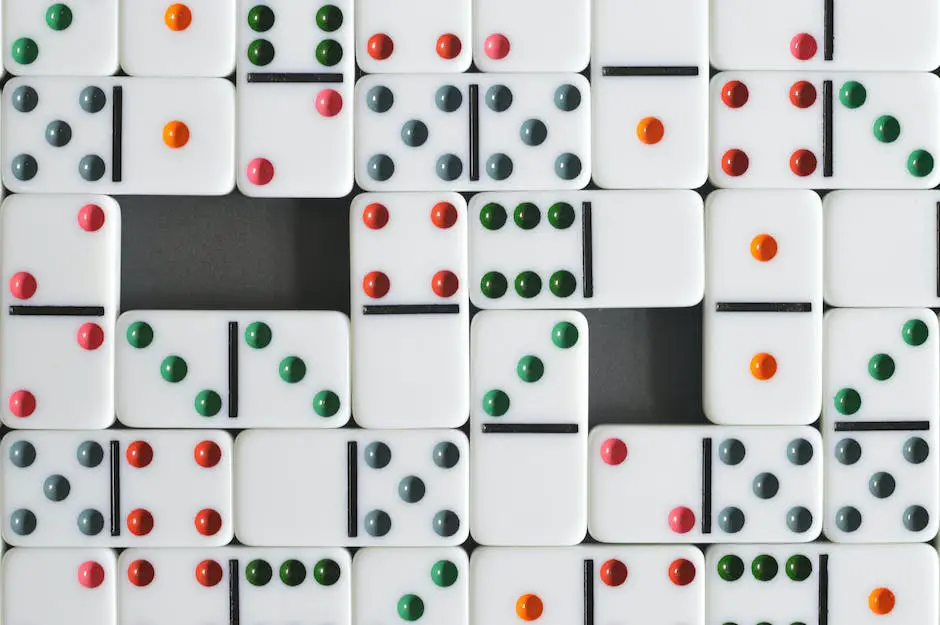
The Game Set-up
1. Gather your equipment:
To play Mexican Train Dominoes, you’ll need a set of standard double-12 dominoes (91 dominoes in total), a score pad, and a writing utensil. You may also use a central ‘Train Station’ hub, which is not required but can be helpful in organizing the game.
2. Shuffle and deal the dominoes:
Place all the dominoes face-down on the table and mix them up. Each player then draws a set number of dominoes to create their starting hand, depending on the number of players in the game:
– 2 to 4 players: Draw 15 dominoes each
– 5 to 6 players: Draw 12 dominoes each
– 7 to 8 players: Draw 10 dominoes each
3. Organize your dominoes:
Each player should arrange their dominoes in such a way that only they can see the face-up side, while other players cannot.
4. Determine the starting double:
The player with the highest double domino (the one where both ends have the same number of dots) places it in the center of the playing area. This will be the starting double for the round. For the first round, the highest double is the double-12; for the second round, it’s the double-11, and so on. If no player has the required starting double, players redraw their hands and try again.
5. Create individual trains:
Starting with the player to the left of the person who placed the starting double, each player takes turns placing a domino with a matching number of dots on one end next to the starting double. This creates their ‘personal train’. The other end of this domino will form the tail end of their train.
6. Create the Mexican Train:
After all players have placed a domino to begin their personal train, a Mexican Train is created. A player places a domino with a matching number of dots on one end next to the starting double. This domino is the beginning of a common train, called the Mexican Train, which all players can play on throughout the game.
7. Create the Train Station Hub (optional):
If using a Mexican Train hub, place it in the center of the table and insert the starting double into the center slot. Each player’s personal train will extend from one of the slots on the hub, while the Mexican Train will branch out from the hub as well.
8. Display your available moves:
If a player cannot play anything on their turn, they must ‘mark’ their train by placing a marker (such as a small coin) next to their personal train. This indicates that other players may now play on that player’s personal train. Remove the marker once the player can legally play a domino on their train in a future turn.Now that the game is set up, players can begin to take turns playing dominoes according to the rules of Mexican Train Dominoes. Remember to keep score and have fun!
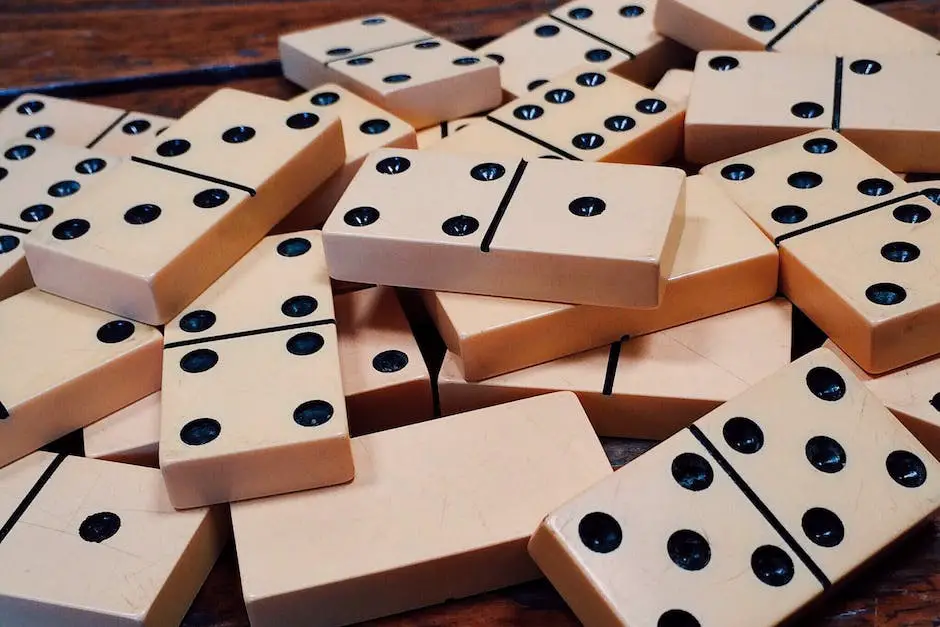
Player Actions and Turns
Mexican Train Dominoes is a fun and engaging game that can be enjoyed by two or more players. It is an ideal pastime for enthusiasts and hobbyists looking to learn new skills and have a great time. To help you get started on your Mexican Train Dominoes journey, here are the basic instructions and player actions you need to know:
Setup:
- Each player selects a set number of dominoes, depending on the total number of players. For example, for 2-4 players, each player gets 15 dominoes, while for 5-6 players, each player gets 12 dominoes.
- The remaining dominoes are placed facedown in a “boneyard.”
- The player with the highest double domino (the double-nine, double-12, or double-15 set) places it in the center of the table. This becomes the starting point or “engine” for that round.
Player Actions and Turns:
- Starting with the player to the left of the one who placed the engine and proceeding clockwise, each player tries to play a matching domino to the engine by connecting one half of the domino to the engine.
- If a player doesn’t have a domino that can be connected to the engine, they must draw one domino from the boneyard. If the drawn domino can be played, they play it immediately. If not, their turn is over.
- After all players have had a turn trying to connect to the engine, their subsequent turns involve connecting dominoes to their personal trains, which are lines of dominoes that branch out from the central engine. Each player’s train must start with a domino that matches the engine’s double.
- A player may also start a “Mexican Train,” which is an additional train line that anyone can play on, starting with a domino matching the engine’s double.
- If a player cannot play on their own train or any other player’s train (during their turn), they must draw a domino from the boneyard. If the drawn domino can be played, they place it on the appropriate train. Otherwise, their turn ends, and they must place a marker (e.g., a penny) on their train, indicating that other players may add dominoes to their train during their turns.
Turn Order:
- The game proceeds in a clockwise order, with each player taking a turn to either play a matching domino on an open train or draw from the boneyard if they cannot play.
- A player’s train becomes “open” to other players once they have placed a marker on it, allowing others to play on their train during their turns.
- Once a player has played all of their dominoes, they are declared the winner of the round. The game can be played in multiple rounds, with each round’s winner scoring the total number of pips (dots) on their opponents’ remaining dominoes. The player with the lowest score after the predetermined number of rounds wins the game.
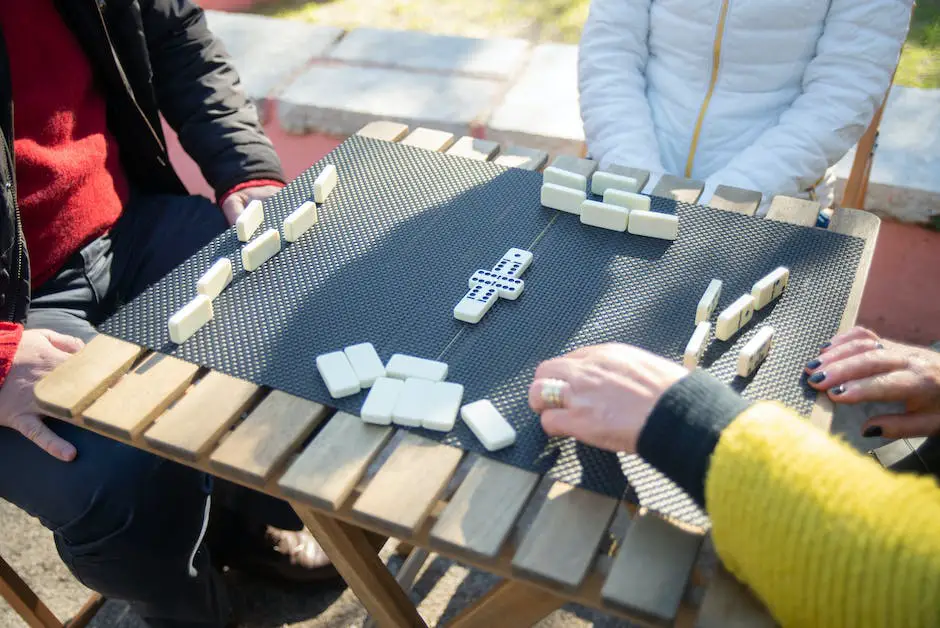
Building and Extending Trains
Setting up the game:
- Each player selects a set of dominoes with a particular number on them. For example, if you’re playing with four players, one person could take all the dominoes with 12s, another with 11s, another with 10s, and another with 9s.
- Place the double domino of the highest number (called the engine) in the center of the table. In the example above, this would be the double-12 domino.
Creating the trains:
- Each player selects their starting domino, which must have their chosen number on one end (called the “personal train marker”) and the engine number on the other end. For example, if your chosen number is 11 and the engine is a double-12, your starting domino could be a 12-11 domino.
- Place your starting domino at the edge of the engine so that one end is touching the engine, and the other faces away from it. This creates the start of a “train.”
Extending the trains:
- On your turn, extend your train by placing a domino with one end that matches the open end of your train. The other end of the domino will be the new open end of your train.
- If you cannot legally place a domino on your train, you must draw a domino from the “boneyard” (the pile of unused dominoes). If the drawn domino can be played, place it on your train. If it cannot be played, place a “marker” next to your train, signifying it is open for other players to play on it on their turns.
Understanding legal placements:
- A domino can only be placed on a train if its ends match the open end of the train. For example, if the open end of your train is a 9, you may only place a domino with a 9 on one end.
- You can place a domino on your own train, or on another player’s “open” train (as indicated by a marker).
- You cannot place a domino on another player’s train that does not have a marker or is not deemed “open.”
Mexican Train:
- At any time during the game, if you draw or have a domino that matches the engine number, you can place it beside the engine (not connected to any existing trains). This starts a new train called the “Mexican Train.”
- The Mexican Train is considered to be an “open” train, meaning anyone can play on it during their turn.
Winning the game:
- The game continues with players building and extending trains until one player runs out of dominoes. This marks the end of the round, and remaining players count the total number of pips (dots) on their remaining dominoes. The player with the lowest accumulated score after a certain number of rounds (usually determined before starting the game) is the winner.
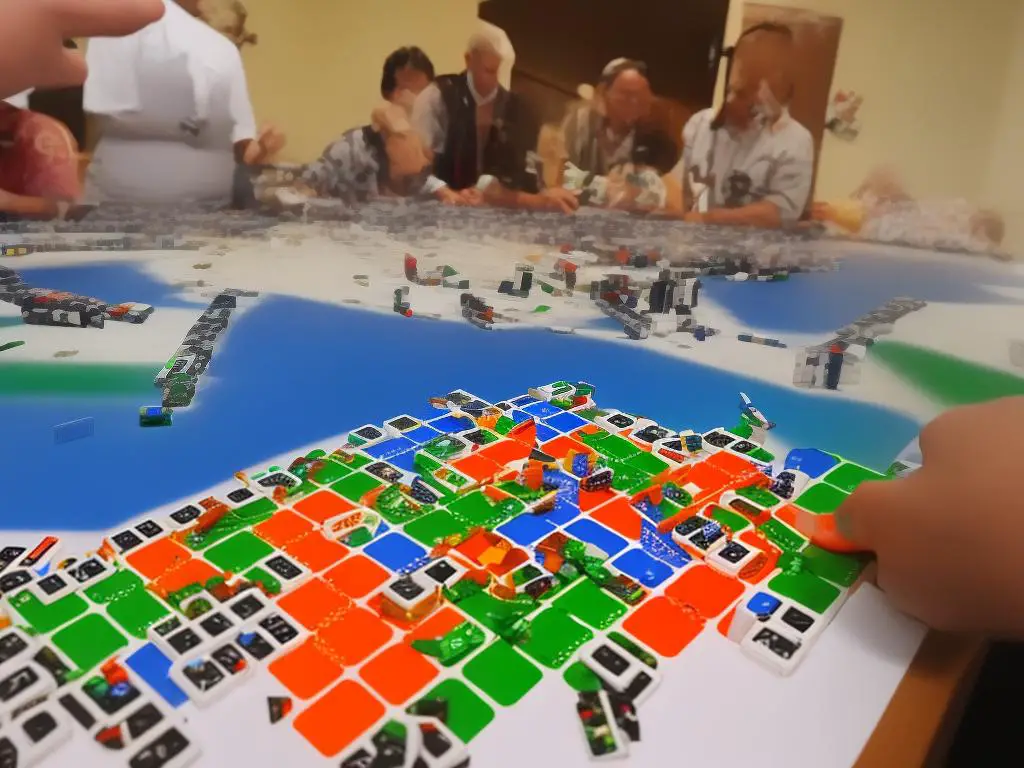
Special Moves
Mexican Train Dominoes is a game that can be enjoyed by enthusiasts and hobbyists of all ages. It is a popular game in which players attempt to create a train of dominoes that runs from a central hub to their personal playing area. In this game, there are special moves that can be made, including playing doubles, drawing from the boneyard, and starting a Mexican Train. Here are instructions on how to make these special moves:
1. Playing Doubles:
When a player has a double (a domino with the same number on both ends), they can make a special move by placing this double on their train. To do this, the double must be placed perpendicular to the end domino of the train it is being played on. When a player puts down a double, they have the option to immediately play another domino on that double, continuing their train. If they can’t or choose not to add another domino, they must “mark” the double by placing a marker (such as a penny) on it. The double remains open for other players to play on during their turns, but the marker indicates who played the double.
2. Drawing from the Boneyard:
If a player cannot make a legal move on their turn, they must draw a domino from the boneyard (the stack of unused dominoes). This is a way to obtain additional dominoes to bolster the player’s hand. The drawn domino must be played if it is a valid play; if not, the player must pass, and their train is marked as open for others to play on by placing a marker, such as a small train, on the end of their train. If there are no more dominoes left in the boneyard, the player simply passes their turn and marks their train open.
3. Starting a Mexican Train:
A Mexican Train is an additional train that can be started by any player at any time during the game, providing they have a domino that matches the number on the central hub. To start a Mexican Train, the player places the domino on one of the available spaces connected to the central hub. The Mexican Train is open for all players to play on during their turn and can be a strategic move to get rid of dominoes that cannot be placed on the player’s personal train.
It’s important to note that only one Mexican Train can be in play at a time.Remember, the goal of Mexican Train Dominoes is to be the first player to play all of their dominoes in their personal train and on the Mexican Train. By mastering these special moves, players can increase their chances of victory and add complexity and enjoyment to the game experience.

Scoring and Winning
Mexican Train Dominoes is a fun and engaging game played with domino tiles. To master the game, it’s essential to understand the process of scoring and determining the winner of each round and the overall game. Follow these step-by-step instructions to learn how to score and win in Mexican Train Dominoes.
1. Finishing a round:
A round ends when a player successfully dominoes (plays all their tiles) or when no player can play any more tiles, which results in a blocked game.
2. Scoring a round:
When a round ends, each player calculates their score by adding up the total number of pips (dots) on the dominoes remaining in their hand. The lower the score, the better.
3. Double dominoes:
If a player has any remaining double dominoes (dominoes with the same value on both ends) in their hand, these count as double points. For example, a double 6 would count as 12 points, and a double 9 would count as 18 points.
4. Winner of a round:
The player who has dominoed (played all of their tiles) is the winner of that round. If the round ends in a blocked game, the player with the lowest score wins the round.
5. Recording scores:
After each round, players should write down their scores on a score sheet. This will make it easier to track scores and determine the overall winner at the end of the game.
6. Starting a new round:
Depending on the agreed-upon rules, the game may be played for a certain number of rounds or until a player reaches a specific score, such as 100 points. At the beginning of each new round, the game starts again with a new starting double domino, one pip lower than the previous round. For example, if the previous round started with a double 12, the next round should begin with a double 11.
7. Winning the game:
The overall winner of the Mexican Train Dominoes game is the player with the lowest cumulative score after all rounds have been played, or when a player reaches the agreed-upon maximum score.Remember that practice makes perfect, so keep playing Mexican Train Dominoes to sharpen your skills and develop your strategies. Enjoy the game and have fun while learning how to score and determine the winner in this classic domino game!
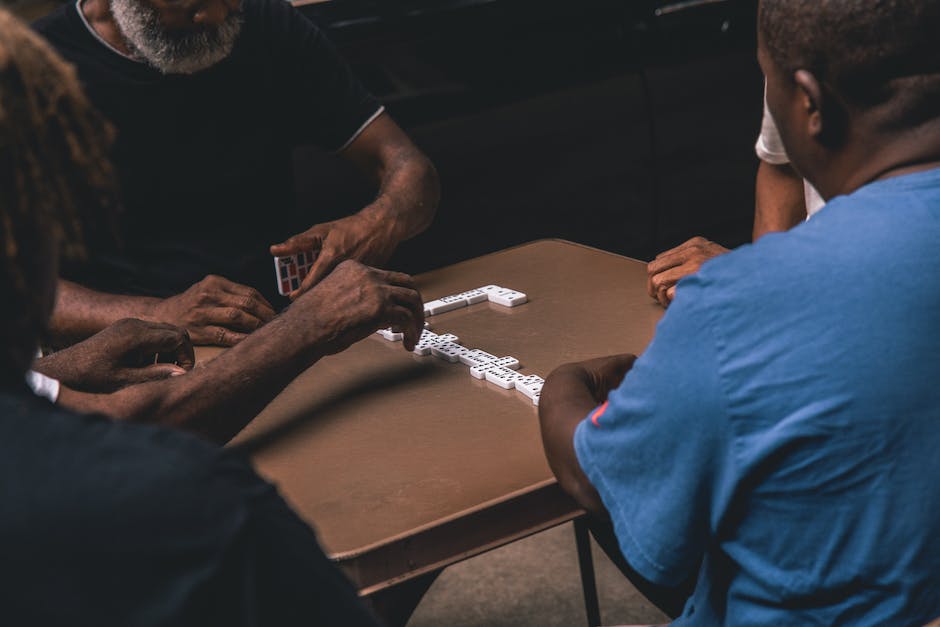
Variations and Strategies
Mexican Train Dominoes is a fun and entertaining game that can be enjoyed by people of all ages. It involves strategy, skill, and a bit of luck. To make the game even more interesting, there are various variations and strategies you can use to improve your chances of winning. In this guide, we will discuss some of these variations and strategies.
Variations:
- Double-9 or Double-12 Domino Set: The standard version of Mexican Train Dominoes is played with a Double-12 domino set, which contains 91 dominoes. However, you can also play the game with a Double-9 domino set, which has 55 dominoes. This variation is suitable for younger players or for a faster game with fewer rounds.
- Number of Trains: The standard game has one train for each player, plus the Mexican Train. In a variation, you can add more “public” trains, which can be played on by any player. This increases the game’s interaction and makes it more challenging.
- Starting Double: Instead of starting with the highest double (double-12), you can choose to start with a lower double or a random double. This can change the game’s dynamic, as the dominoes in play will differ in each round.
- Sequential Doubles: By implementing sequential doubles gameplay, you would start the first round with double-12 and then work your way down to double-0 in each subsequent round.
- End of Round Scoring: At the end of each round, players add the total number of pips (dots) on their remaining dominoes. Some variations have the winner of the round score the sum of all other players’ remaining pips. Alternatively, each player can score their remaining pips individually.
Strategies:
- Plan Your Moves: Analyze your initial hand and try to visualize possible plays. Keep track of which dominoes have been played and anticipate what your opponents might play next. This will help you plan your moves and create a winning strategy.
- Manage Your Trains: Keep an eye on your train and your opponents’ trains. If possible, try to block other players’ trains while keeping your train open for your moves. This will prevent your opponents from discarding their dominoes and force them to draw more dominoes from the pile.
- Take Advantage of Doubles: Since doubles must be followed by another domino in a Mexican Train game, playing doubles strategically can prolong your opponents’ turns or even block their trains. Also, pay attention to doubles in your hand, as they may become dead-ends if not played wisely.
- Keep Your Options Open: While it’s essential to have a plan in place, it’s equally important to maintain flexibility. Try to keep dominoes in your hand with a variety of numbers, so you have more options when connecting to the trains. This will increase your chances of making a valid move and reduce your need to draw from the pile.
- Use the Mexican Train Wisely: The Mexican Train is an additional train that any player can play on. You can use this to your advantage by discarding your higher value dominoes or troublesome doubles onto the Mexican train, so you don’t get stuck with them in case the round ends.

Etiquette and Sportsmanship
Know the Basic Rules: Familiarize yourself with the basic rules of Mexican Train Dominoes before playing the game. This includes knowing the objective of the game, how to set up the dominoes, and how each round is played. It is important to understand and follow the rules to ensure a fair and enjoyable game for everyone involved.
Be Respectful: Always treat your fellow players with respect, regardless of their skill level or experience with the game. Do not ridicule or talk down to other players, and avoid reacting negatively to their mistakes or misfortunes. Encourage new players and help them understand the rules and strategies of the game.
Take Turns Properly: Make sure to take turns in a clockwise order and wait for your turn before making a move. Do not interrupt other players while they are taking their turn, and be mindful not to take too long when it is your turn to play.
Communicate Clearly: It is important to communicate your moves clearly and effectively with your fellow players. When adding a domino to the board, announce the number of the train you are adding to, and ensure the other players can see the domino being played. If you cannot play, make sure to announce that you are passing your turn.
Keep Track of Your Own Score: At the end of each round, players should calculate their own scores based on the dominoes remaining in their hand. It is considered good sportsmanship to keep track of your own score and report it honestly to the other players.
Be A Gracious Loser (and Winner): Whether you win or lose, it is important to be gracious and maintain a positive attitude. Congratulate the winner at the end of the game and do not make excuses or blame other players for your loss. If you win, be humble and thank your fellow players for a good game.
No Cheating: Do not cheat or bend the rules in your favor. This includes swapping or hiding dominoes, spying on other players’ hands or intentionally providing misinformation about the rules. Cheating not only takes away from the integrity of the game but also diminishes the enjoyment of the other players.
Help with Clean Up: At the end of the game, offer to help clean up the playing area and put away the dominoes. This shows respect for your fellow players and the environment in which you played the game.
Encourage Conversation and Laughter: Mexican Train Dominoes is a social game, so engage in friendly conversation and laughter throughout the game. This can create a positive atmosphere and make the game even more enjoyable for everyone involved.

Now that you’ve learned the ins and outs of Mexican Train Dominoes, it’s time to gather your friends or family and experience the game for yourself. Remember, the key to success in this game lies in mastering the various strategies, variations, and maintaining good sportsmanship. As you continue to practice and improve, you’ll find yourself enjoying this wonderful game even more. So grab your dominoes and let the fun begin!
Frequently Asked Questions
Q: What is Mexican Train Dominoes?
A: Mexican Train Dominoes is a popular multiplayer domino game that involves placing dominoes in a chain-like pattern, known as the “train.” The objective is to be the first player to run out of dominoes.
Q: How many players can participate in Mexican Train Dominoes?
A: Mexican Train Dominoes can be played with 2 to 8 players, making it suitable for both small and large groups.
Q: What are the basic rules of Mexican Train Dominoes?
A: Players take turns placing matching dominoes on their own train or the “Mexican Train.” If a player cannot make a move, they draw from the boneyard. The double dominoes have special significance in gameplay.
Q: How do I start the Mexican Train in the game?
A: The person with the highest double domino starts their own train and the Mexican Train. If no one has a double, the highest-ranked domino becomes the starting piece.
Q: Can I block other players in Mexican Train Dominoes?
A: Yes, you can block other players by not allowing them to play on their own trains. This strategic move can add complexity to the game.
Q: What happens when a player runs out of dominoes?
A: When a player plays their last domino, the round ends, and players calculate their remaining dominoes’ total pip count as points. The game usually consists of multiple rounds.
Q: Are there any variations to Mexican Train Dominoes?
A: Yes, there are variations, including different scoring methods, special rule additions, and variations in starting conditions.
Q: Where can I find more game guides and resources?
A: For more game guides and resources, visit CardsAndBoards.net. Explore our collection of engaging games for endless entertainment!
If you are looking to purchase a version of Mexican Card Dominos you can do so from Amazon here!